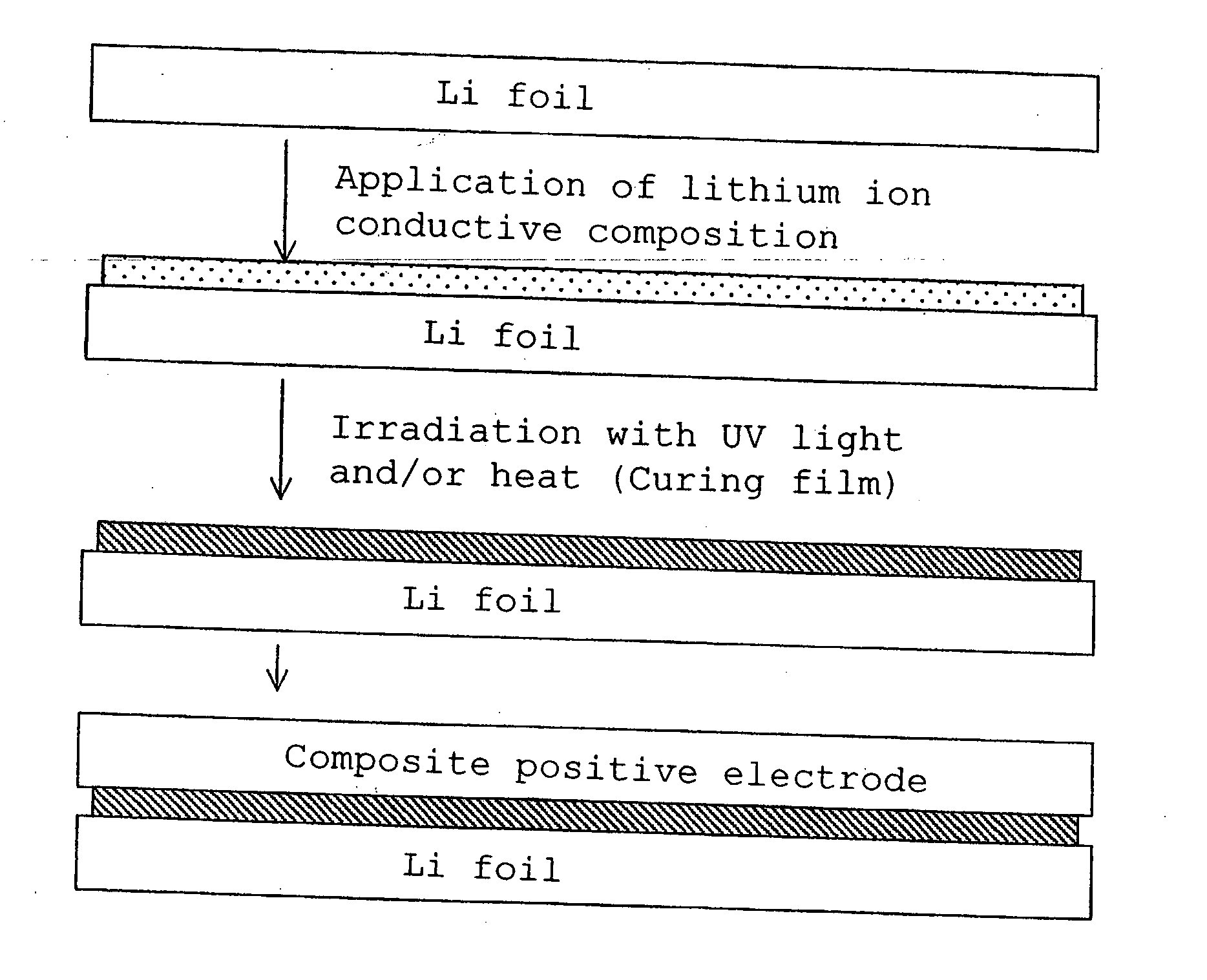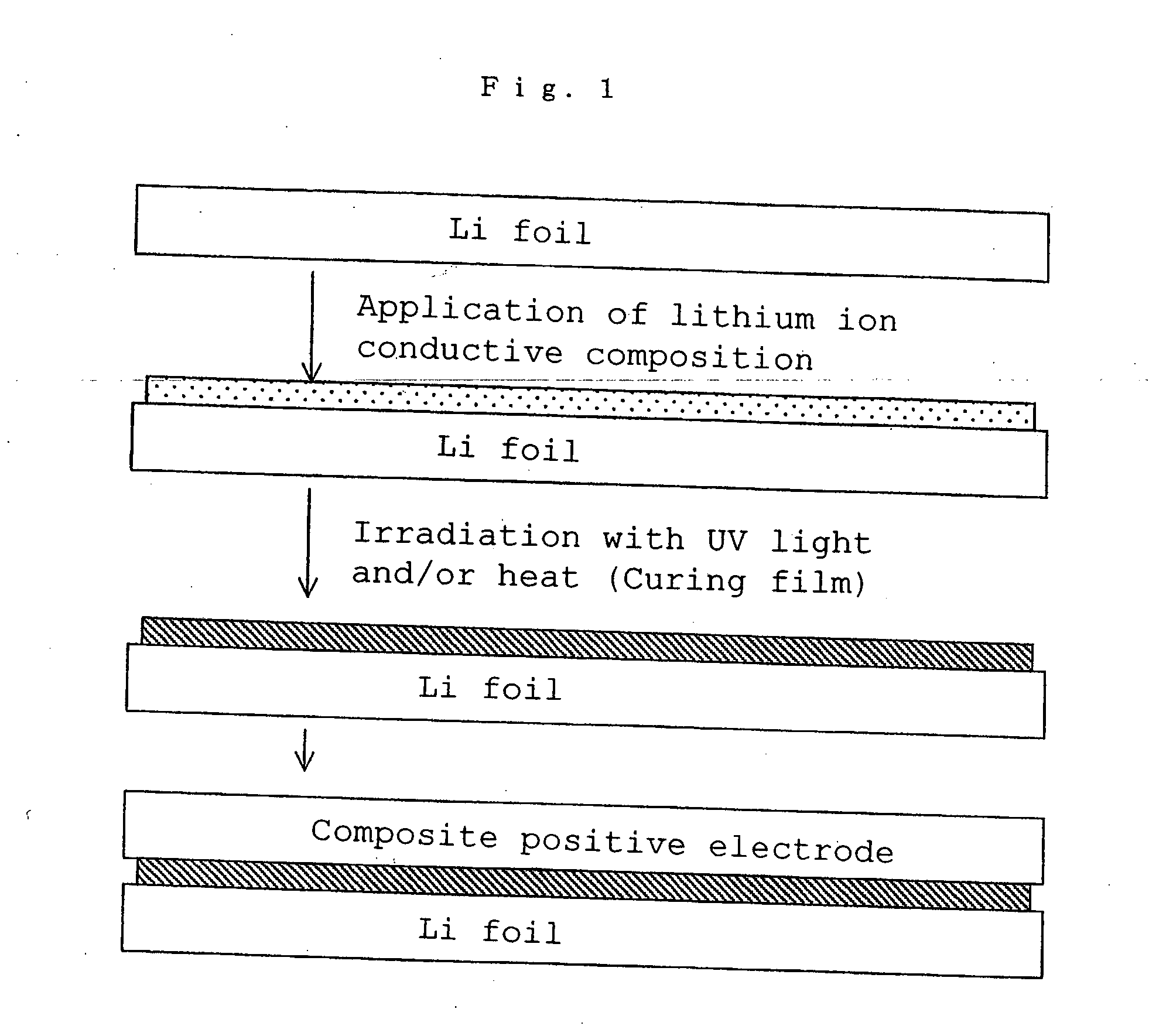Lithium polymer cell and manufacturing method thereof
a polymer cell and polymer technology, applied in the field can solve the problems of degrading cell performance, affecting the quality reducing the efficiency of lithium polymer cells, so as to facilitate the control of each manufacturing step
- Summary
- Abstract
- Description
- Claims
- Application Information
AI Technical Summary
Benefits of technology
Problems solved by technology
Method used
Image
Examples
reference example 1
Dry air was introduced to a reaction vessel equipped with a stirrer, thermometer, reflux condensor and air inlet pipe, and 160 parts of isophorone diisocyanate (manufactured by Degussa-Huls AG, “VESTANAT IPDI”), 755 parts of ethylene oxide / propylene oxide block polyetherpolyol (manufactured by Asahi Denka Kogyo K.K., “CM-211”, weight average molecular weight of about 2100) were placed therein, and then the mixture was heated to 70° C. Thereafter, a mixture solution comprising 85 parts of 2-hydroxyethyl acrylate, 0.4 parts of hydroquinone monomethyl ether and 0.1 parts of dibutyltin dilaurate (manufactured by Tokyo Fine Chemical Co., Ltd., “LIOI”) was uniformly added thereto dropwise over 3 hours, and allowed to react. After completion of dropwise addition, the mixture was reacted for about 5 hours and then reaction was stopped after ensuring the disappearance of isocyanate by IR measurement, obtaining urethane acrylate (solid content: 99.8%, number average molecular weight: 4300). ...
reference example 2
Dry air was introduced to a reaction vessel equipped with a stirrer, thermometer, reflux condensor and air inlet pipe, and 170 parts of isophorone diisocyanate (manufactured by Degussa-Huls AG, “VESTANAT IPDI”), 741 parts of ethylene oxide / propylene oxide random polyetherpolyol (manufactured by Asahi Denka Kogyo K.K., “PR-2008”, weight average molecular weight of about 2000) were placed therein, and then the mixture was heated to 70° C. Thereafter, a mixture solution comprising 89 parts of 2-hydroxyethyl acrylate, 0.4 parts of hydroquinone monomethyl ether and 0.1 parts of dibutyltin dilaurate (manufactured by Tokyo Fine Chemical Co., Ltd., “LIOI”) was uniformly added thereto dropwise over 3 hours, and allowed to react. After completion of dropwise addition, the mixture was reacted for about 5 hours and then reaction was stopped after ensuring the disappearance of isocyanate by IR measurement, obtaining urethane acrylate (solid content: 99.8%, number average molecular weight: 2700)...
reference example 3
Dry air was introduced to a reaction vessel equipped with a stirrer, thermometer, reflux condensor and air inlet pipe, and 97 parts of isophorone diisocyanate (manufactured by Degussa-Huls AG, “VESTANAT IPDI”), 870 parts of ethylene oxide / propylene oxide random polyetherpolyol (manufactured by Asahi Denka Kogyo K.K., “PR-3007”, weight average molecular weight of about 3000) were placed therein, and then the mixture was heated to 70° C. Thereafter, a mixture solution comprising 33 parts of 2-hydroxyethyl acrylate, 0.4 parts of hydroquinone monomethyl ether and 0.1 parts of dibutyltin dilaurate (manufactured by Tokyo Fine Chemical Co., Ltd., “LIOI”) was uniformly added thereto dropwise over 3 hours, and allowed to react. After completion of dropwise addition, the mixture was reacted for about 5 hours and then reaction was stopped after ensuring the disappearance of isocyanate by IR measurement, obtaining urethane acrylate (solid content: 99.8%, number average molecular weight: 7000)....
PUM
| Property | Measurement | Unit |
|---|---|---|
| thickness | aaaaa | aaaaa |
| thickness | aaaaa | aaaaa |
| thickness | aaaaa | aaaaa |
Abstract
Description
Claims
Application Information
 Login to View More
Login to View More - R&D
- Intellectual Property
- Life Sciences
- Materials
- Tech Scout
- Unparalleled Data Quality
- Higher Quality Content
- 60% Fewer Hallucinations
Browse by: Latest US Patents, China's latest patents, Technical Efficacy Thesaurus, Application Domain, Technology Topic, Popular Technical Reports.
© 2025 PatSnap. All rights reserved.Legal|Privacy policy|Modern Slavery Act Transparency Statement|Sitemap|About US| Contact US: help@patsnap.com



